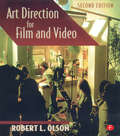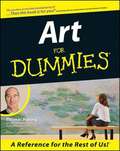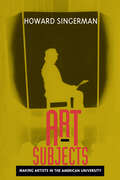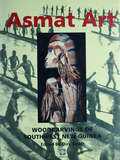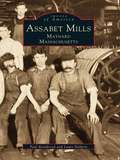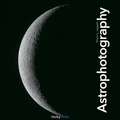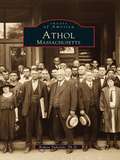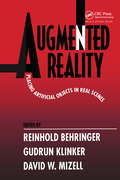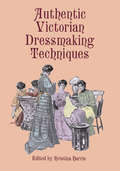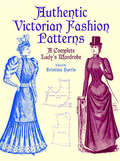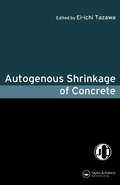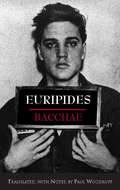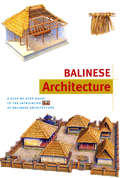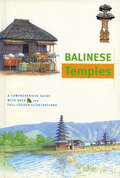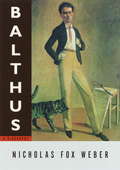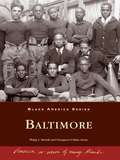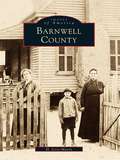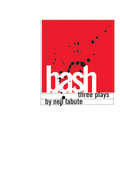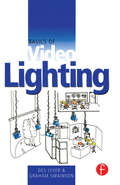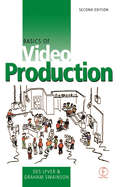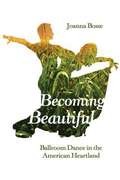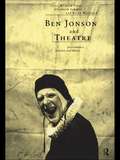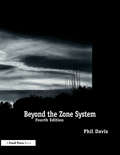- Table View
- List View
Art Direction for Film and Video
by Robert OlsonWritten by an author with over 30 years of working experience, this book takes a practical, thorough look at the duties and skills of art directors and production designers. It teaches readers how to analyze a script, develop concepts that meet the needs of a script, develop sketches and construction drawings, work with directors and producers, and operate within budget limitations. The book has been updated and expanded to include interviews with professionals at all levels in the art department. A chapter on digital effects as they relate to the work of the art director has been added to this new edition. Students, novices in the profession, and persons from other art/design fields who are interested in expanding into film and video will find this is a valuable resource. Written by an author with over 30 years of working experience, this book takes a practical, thorough look at the duties and skills of art directors and production designers. It teaches readers how to analyze a script, develop concepts that meet the needs of a script, develop sketches and construction drawings, work with directors and producers, and operate within budget limitations. The book has been updated and expanded to include interviews with professionals at all levels in the art department. A chapter on digital effects as they relate to the work of the art director has been added to this new edition. Students, novices in the profession, and persons from other art/design fields who are interested in expanding into film and video will find this is a valuable resource.
Art For Dummies
by Thomas Hoving Andrew WyethIf you've always wanted to find out more about art but felt intimidated by the overeducated art world, then you've found the answer. Art For Dummies is the book that will have you and everyone you know clamoring outside the doors of your local museum. Thomas Hoving, former director of New York's Metropolitan Museum of Art, is credited with revolutionizing the Met, doubling its size during his tenure, and bringing art to the masses. Let him bring art to you as well. In Art For Dummies, Thomas Hoving provides a how-to guide to the art world. First, he guides you through an introduction to art appreciation, pointing out the details that you've always noticed but have never been able to explain. Next, Hoving takes you on a ride through art history. (Have you ever regretted not taking those art history classes in school With Art For Dummies, you'll feel all caught up and ready to spar with the local intellectuals. ) Hoving even includes a guide to the world?s top art cities and centers, a listing that can help you prepare for your next artistic voyage. With this guide, you can discover where to go in order to see the greatest works of art, and you can also find out about hidden treasures in nearby art museums. You also get a great start for seeking out art with Hoving's lists of the greatest works of Western civilization, the most interesting artists, and the contemporary artists to watch. Don't wait another day to introduce yourself to the art world!
Art Subjects: Making Artists in the American University
by Howard SingermanNearly every artist under the age of fifty in the United States today has a Master of Fine Arts degree. Howard Singerman's thoughtful study is the first to place that degree in its proper historical framework and ideological context. Arguing that where artists are trained makes a difference in the forms and meanings they produce, he shows how the university, with its disciplined organization of knowledge and demand for language, played a critical role in the production of modernism in the visual arts. Now it is shaping what we call postmodernism: like postmodernist art, the graduate university stresses theory and research over manual skills and traditional techniques of representation.Singerman, who holds an M.F.A. in sculpture as well as a Ph.D. in Visual and Cultural Studies, is interested in the question of the artist as a "professional" and what that word means for and about the fashioning of artists. He begins by examining the first campus-based art schools in the 1870s and goes on to consider the structuring role of women art educators and women students; the shift from the "fine arts" to the "visual arts"; the fundamental grammar of art laid down in the schoolroom; and the development of professional art training in the American university. Singerman's book reveals the ways we have conceived of art in the past hundred years and have institutionalized that conception as atelier activity, as craft, and finally as theory and performance.
Asmat Art
by Dirk SmidtThis book presents a full range of Asmat woodcarving art, but emphasizes the rare early shields and figure sculptures in the collection of the Rijksmuseum voor Volkenkunde, the National Museum of Ethnology in Leiden. Drums, canoeprowheads and the larger, more dramatic "objects" are also shown. * Together with bisj poles, war shields are perhaps the most famous creation of Asmat artists, and these were carved throughout the region. It is in the design and construction of the shields that the variations in style region can most clearly be seen. Figure sculptures, of varying styles, are also well represented here, and a limited number of the huge ceremonial carvings, such as bisj poles and basu suangkus, have also been included. The cultural context in which these items play their part is described in detail in the introductory chapters. But it is not the intention of this book to be an ethnography. The focus is on the art pieces themselves.
Asmat Art
by Dirk SmidtThis book presents a full range of Asmat woodcarving art, but emphasizes the rare early shields and figure sculptures in the collection of the Rijksmuseum voor Volkenkunde, the National Museum of Ethnology in Leiden. Drums, canoeprowheads and the larger, more dramatic "objects" are also shown. * Together with bisj poles, war shields are perhaps the most famous creation of Asmat artists, and these were carved throughout the region. It is in the design and construction of the shields that the variations in style region can most clearly be seen. Figure sculptures, of varying styles, are also well represented here, and a limited number of the huge ceremonial carvings, such as bisj poles and basu suangkus, have also been included. The cultural context in which these items play their part is described in detail in the introductory chapters. But it is not the intention of this book to be an ethnography. The focus is on the art pieces themselves.
Assabet Mills: Maynard, Massachusetts
by Lewis Halprin Paul BoothroydThe sleepy town of Assabet Village woke up very quickly when the Assabet Mills was built in 1847. Dams were constructed on the river, millponds were created, and large mills began producing yarn and carpets. Soon the village was turning into a town with stores, churches, schools, and government. As the mill grew, so did the town; the population grew to 7,000 people by 1905. During good times, the mill prospered, but during bad times, it faltered and had to re-invent itself. It had almost as many lives asthe proverbial cat. The carpet mill faltered in 1857, but in 1862, the Assabet Manufacturing Company started producing woolen materials and blankets to support the Civil War. This mill faltered in 1898, but in 1899, the American Woolen Company bought themills and greatly expanded them. In 1950, the woolen company faltered and shut down completely, but in 1957, Digital Equipment moved in. Digital faltered in 1997 and sold the buildings to Clock Tower Place, which is converting the mills into first-class industrial space. Today, the mills are attracting a new set of small industries. This book is filled with images of the various "lives" of the mill complex. Photographs featured within these pages show mill employees at work and at play; workers' homes; the evolution of the mill buildings; and the products produced and sold by the mill. There is even a chapter that shows how wool products are produced.
Astrophotography
by Thierry LegaultToday's photographic equipment allows amateurs to take pictures of the stars that far surpass images taken just a few decades ago by even the largest observatories-and this book will teach you how.Author and world-renowned astrophotographer Thierry Legault teaches the art and techniques of astrophotography: from simple camera-on-tripod night-scene imaging of constellations, star trails, eclipses, artificial satellites, and polar auroras to more intensive astrophotography using specialized equipment for lunar, planetary, solar, and deep-sky imaging. Legault shares advice on equipment and guides you through techniques to capture and process your images to achieve spectacular results.Astrophotography provides the most thorough treatment of the topic available. This large-format, richly illustrated book is intended for all sky enthusiasts-newcomers and veterans alike.Learn how to:Select the most useful equipment: cameras, adapters, filters, focal reducers/extenders, field correctors, and guide telescopes Set up your camera (digital, video, or CCD) and your lens or telescope for optimal resultsPlan your observing sessionsMount the camera on your telescope and focus it for razor-sharp imagesPolar-align your equatorial mount and improve tracking for pin-point star imagesMake celestial time-lapse videosCalculate the shooting parameters: focal length and ratio, field of view, exposure time, etc.Combine multiples exposures to reveal faint galaxies, nebulae details, elusive planetary structures, and tiny lunar craters Adjust contrast, brightness, light curves, and colorsPostprocess your images to fix defects such as vignetting, dust shadows, hot pixels, uneven background, and noiseIdentify problems with your images and improve your results
Athol, Massachusettes
by Robert TuholskiNestled among the hills of Massachusetts, 70 mileswest of Boston, Athol lies on the banks of the Millers River. First settled as "Pequoiag" in 1735 and incorporated as Athol in 1762, the evolution of Athol from a sparse, agrarian settlement to a bustling industrial community is a blueprint for the transformation of small-town America. This exciting collection presents a visual history of Athol at the dawn of the twentieth century. Athol, Massachusettsdocuments the changes as the town developed from an agrarian community into a thriving manufacturing center that harnessed Mill Brook and the Millers River to power the early mills. Through photographs, stereo cards, and postcards from a bygone era, this book provides a glimpse of what it was like to live and work in the Athol of long ago. The photographs from years gone by allow both young and old to meander down dirt roads along the stream, and become witness to their celebrations and their recreational retreats at the fairgrounds, Silver Lake, and Brookside Park.
Augmented Reality: Placing Artificial Objects in Real Scenes
by Gudrun Klinker Reinhold Behringer David W. MizellThis book presents a variety of techniques that combine computer-generated images and other objects with real scenes, creating augmented reality. This work provides an excellent snapshot of the current state of augmented reality research and its latest applications to industry. Using computer vision, graphics, and signal processing, augmented reali
Authentic Victorian Dressmaking Techniques (Dover Fashion and Costumes)
by Kristina HarrisAt the turn of the century, ladies of privilege could easily afford their own dressmakers, and even middle-class housewives occasionally employed competent seamstresses. But many women did their own sewing, often relying on Dressmaking, Up to Date, a how-to book published by the Butterick Publishing Company. First published in 1905 and widely considered the first modern American sewing book, this extremely rare volume is published here complete and unabridged.This Butterick manual provides clear and concise instructions for altering patterns, hand-sewing stitches, and creating shirt-blouses, skirts, wedding and evening gowns, coats, jackets, maternity wear, undergarments, bathrobes, children's clothing, and many other articles of apparel. Today's costume historians and sewing enthusiasts will find fascinating instruction in such long-lost arts as boning a bodice perfectly, creating skirt sweepers and bust enhancers, concealing hooks and eyes, and other vintage dressmaking techniques.An indispensable archive of information on late-Victorian and turn-of-the-century clothing, this volume will be of immense interest to anyone fascinated by the fashion and costume of the period. It will also be of value to needleworkers wanting to create accurate reproductions of Victorian-era costume, or to anyone interested in applying time-honored sewing techniques to a modern wardrobe.
Authentic Victorian Fashion Patterns: A Complete Lady's Wardrobe
by Kristina HarrisRich selection of scaled dressmaker's patterns from the popular late 19th-century magazine The Voice of Fashion details 50 garments for women, from handsome daytime and evening dresses to casual tennis outfits, a riding habit, and undergarments. Of practical use for costume designers and students of fashion; will also delight browsers. 498 illustrations.
Autogenous Shrinkage of Concrete: Proceedings Of The International Workshop Organized By Jci (japan Concrete Institute)
by Ei-Ichi TazawaThis book forms the proceedings of a workshop held in Hiroshima in June 1998 and derive from the work of a Technical Committee of the Japan Concrete Institute. Topics include test and prediction methods, the science of autogenous shrinkage, strain and stress, and consequent design concerns.
Bacchae
by Euripides Paul Woodruff[Woodruff's translation] is clear, fluent, and vigorous, well thought out, readable and forceful. The rhythms are right, ever-present but not too insistent or obvious. It can be spoken instead of read and so is viable as an acting version; and it keeps the lines of the plot well focused. The Introduction offers a good survey of critical approaches. The notes at the foot of the page are suitably brief and nonintrusive and give basic information for the non-specialist. --Charles Segal, Harvard University
Balinese Architecture Discover Indonesia
by Julian Davison Bruce GranquistBalinese Architecture is a step-by-step guide to the intricacies of Balinese vernacular architecture, the written word being complemented throughout by watercolor illustrations of different building types, design concepts and construction techniques.
Balinese Temples
by Julian Davison Bruce GranquistBali is an island with literally tens of thousands of temples, a proliferation of religious architecture probably not equaled anywhere else in the world.This book is intended as a general introduction to the architectural symbolism of the typical Balinese temple and the cosmological significance of its layout. The informative text is complemented by dozens of watercolor illustrations and will provide a useful guide to many of the temples that the reader is likely to visit during a stay on the island.
Balthus
by Nicholas Fox WeberThe first full-scale biography of one of the most elusive and enigmatic painters of our time -- the self-proclaimed Count Balthus Klossowski de Rola -- whose brilliantly rendered, markedly sexualized portraits, especially of young girls, are among the most memorable images in contemporary art.The story of Balthus's life has been shrouded by contradiction and hearsay, most of it his own invention; over the years he created for himself a persona of mystery, aristocracy, and glamour. Now, in Nicholas Fox Weber's superb biography, Balthus, the man and the artist, stands revealed as never before. He was born in Paris in 1908 to Polish parents. At age twelve he first stepped into the spotlight with the publication of forty of his drawings illustrating a story about a cat by Rainer Maria Rilke, who was then Balthus's mother's lover and a crucial influence on the young boy. From that moment, Balthus has never been out of the public eye. In 1934 his first exhibition, in Paris, stunned the art world. The seven canvases drew attention to his extraordinary technique -- a mix of tradition and imagination informed by the work of Piero della Francesca, Courbet, and Joseph Reinhardt, but unique to the twenty-six-year-old artist -- and to their provocative content; one of the paintings, The Guitar Lesson, was so powerful in its sadomasochistic imagery that it was deemed necessary to remove it from public display. Continuously since then, Balthus's work has provoked both great opprobrium and profound admiration -- as has the artist himself, whether collaborating with Antonin Artaud on his Theater of Cruelty, transforming the Villa Medici into the social center of Fellini's Rome in the 1950s, or competing for the artistic limelight with his friends Picasso and André Derain.The artist's complexities are clarified and his genius understood in a book that derives its particular immediacy from Weber's long and intense conversations with Balthus -- who never previously consented to discuss his life and work with a biographer -- as well as his interviews with the painter's closest friends, members of his family, and many of the subjects of his controversial canvases.Weber's critical and human grasp (he acutely analyzes the paintings in terms of both their aesthetic achievement and what they reveal of their maker's psyche), combined with his rich knowledge of Balthus's life and his insight into the ideas and forces that have helped to shape Balthus's work over the past seven decades, gives us a striking, illuminating portrait of one of the most admired and outrageous artists of our time.
Baltimore (Black America Series)
by Uluaipou-O-Malo Aiono Philip J. MerrillThroughout the years, the city of Baltimore has played host to many well-known figures, including Louis Armstrong, Duke Ellington, and boxer Joe Louis; the city has been called home by Billie Holiday, Frederick Douglass, and Thurgood Marshall. But it is the local African-American community's members, working diligently to advance and empower themselves, who made history while they lived it.
Barnwell County
by H. Jerry MorrisBarnwell County, an area blessed with sweeping rural landscapes, has played an important role in South Carolina's distinguished history, from its roots in agriculture to its development of the government-owned Savannah River Plant. This visual history celebrates many of the county's small towns, such as Barnwell, Williston, and Blackville, and includesfascinating images of some of the smaller communities. In Barnwell County, you will experience an incredible visual tour of yesteryear, viewing Barnwell County through both photographs and postcards from the turn of the twentieth century to the 1960s. As you thumb through these pages, you will stroll along dusty downtown streets; visit the local train depots; read the time on the vertical sundial located next to the Barnwell Courthouse; explore the facilities of the German Prisoner of War Camp and see some of its inmates hard at work;investigate many of the old, wooden-frame churches scattered throughout the county; sit in on classes in one-room schoolhouses, including many of the African-American schools in the 1930s; watch trucks lumbering along dirt roads and balancing large homes from Dunbarton on their truckbeds; meet a few of Barnwell County's more prominent citizens, such as C.G. Fuller, Representative Sol Blatt, and Senator Edgar Brown; and enjoy a variety of everyday activities, such as hunting, scouting, attending family reunions, or riding in classic automobiles along county roads.
Bash: Three Plays
by Neil LabuteA trio of brilliantly scathing plays by the renowned writer-director of In the Company of Men and Your Friends and Neighbors. With the success of his first two films, In The Company of Men and Your Friends and Neighbors, writer-director Neil LaBute has been hailed as a first-rate dramatic talent with a caustic wit reminiscent of Stanley Kubrick. bash—a collection of three stunning one-act plays that mark LaBute’s return to the New York stage after ten years—forms a trio of unforgettable personal accounts: in Medea Redux, a woman tells of her complex and ultimately tragic relationship with her grade school English teacher; in Iphigenia in Orem, a Utah businessman confides in a stranger in a Las Vegas hotel room, confessing a most chilling crime; and in A Gaggle of Saints, a young Mormon couple separately recounts the violent events of an anniversary weekend in New York City. All three are unblinking portraits of the complexities of evil in everyday life, exhibiting LaBute’s signature raw lyrical intensity.
Bash: Three Plays
by Neil LabuteA trio of brilliantly scathing plays by the renowned writer-director of In the Company of Men and Your Friends and Neighbors. <P> With the success of his first two films, In The Company of Men and Your Friends and Neighbors, writer-director Neil LaBute has been hailed as a first-rate dramatic talent with a caustic wit reminiscent of Stanley Kubrick. bash--a collection of three stunning one-act plays that mark LaBute's return to the New York stage after ten years--forms a trio of unforgettable personal accounts: in Medea Redux, a woman tells of her complex and ultimately tragic relationship with her grade school English teacher; in Iphigenia in Orem, a Utah businessman confides in a stranger in a Las Vegas hotel room, confessing a most chilling crime; and in A Gaggle of Saints, a young Mormon couple separately recounts the violent events of an anniversary weekend in New York City. All three are unblinking portraits of the complexities of evil in everyday life, exhibiting LaBute's signature raw lyrical intensity.
Basics of Video Lighting
by Des Lyver Graham SwainsonNow fully updated by Des Lyver to reflect the latest advances, the second edition of Basics of Video Lighting is a primer for anyone wishing to learn about lighting a video production. It describes the principles and processes involved in obtaining professional results in educational, training and corporate environments. Assuming little prior knowledge, this book covers everything from the different types of lights and their control, to basic studio and location settings. It features:· the latest technology, including the use of location and grip gear and changes in lamp and reflector technology · coverage of studio and location work· descriptions of the role of each crew member · full explanations of technical terms· health and safety precautions· practical advice on the equipment available and how to use itBasics of Video Lighting aims to provide the reader with a rapid understanding of what is actually a complex process, without getting too bogged down in technical terms. It is equipment non-specific and references to technical matters are only included where necessary to understanding, for example a short explanation of the simple electricity that is needed to understand the relationship between the camera and the lights.
Basics of Video Production (Basics Of Ser.)
by Des Lyver Graham SwainsonNow fully updated by Des Lyver to reflect the latest advances, the second edition of Basics of Video Production is a primer for anyone wishing to learn about video production. It describes the principles and processes involved in obtaining professional results in educational, training and corporate environments. Assuming little prior knowledge, this book takes the reader on a guided tour around a studio or location production, examining the production process from conceptualisation to the final screening. It features:· the latest advances in low cost non-linear editing and digital video· coverage of studio and location work· descriptions of the role of each crew member · full explanations of technical terms· health and safety precautions· practical advice on the equipment available and how to use itBasics of Video Production aims to provide the reader with a rapid understanding of what is actually a complex process, without getting too bogged down in technical terms. It is equipment non-specific and references to technical matters are only included where necessary to understanding. Much of what is contained in this book will be directly transferable to film and sound courses as the basics and principles are the same.
Becoming Beautiful: Ballroom Dance in the American Heartland
by Joanna BosseIn Becoming Beautiful, Joanna Bosse explores the transformations undergone by the residents of a Midwestern town when they step out on the dance floor for the very first time. Bosse uses sensitive fieldwork as well as her own immersion in ballroom culture to lead readers into a community that springs up around ballroom dance. The result is a portrait of the real people who connect with others, change themselves, and join a world that foxtrots to its own rules, conventions, and rewards. Bosse's eye for revealing, humorous detail adds warmth and depth to discussions around critical perspectives on the experiences the dance hall provides, the nature of partnership and connection, and the notion of how dancing allows anyone to become beautiful.
Ben Jonson and Theatre: Performance, Practice and Theory
by Brian Woolland Richard Cave Elizabeth SchaferBen Jonson and Theatre is an investigation and celebration of Jonson's plays from the point of view of the theatre practitioner as well as the teacher. Reflecting the increasing interest in the wider field of Renaissance drama, this book bridges the theory/practice divide by debating how Jonson's drama operates in performance. Ben Jonson and Theatre includes: * discussions with and between practitioners * essays on the staging of the plays * edited transcripts of interviews with contemporary practitioners The volume includes contributions from Joan Littlewood, Sam Mendes, John Nettles, Simon Russell Beale and Geoffrey Rush, Oscar-winning actor for Shine.
Beyond the Zone System
by Phil DavisThis fourth edition of Beyond the Zone System makes the science of photographic sensitometry both accessible and useful to interested photographers. It will appeal to any serious photographer interested in knowing how the materials and processes of black-and-white photography work. Instead of describing rote procedures to be followed blindly, this book provides the basis for understanding what needs to be done and why. This book relates theory to practice in a way that promotes a true partnership of science and art. Beyond the Zone System bridges the gap between the more theoretical aspects of the photographic process and the popular empirical procedures used by many photographers in the attempt to predict and control the quality of their photographs in practice.This book is intended primarily for photographers who use large-format cameras and black-and-white sheet film, but the basic information about how the B&W photographic materials and processes work will be useful to users of any B&W film format.Beyond the Zone System, 4th ed. will appeal to any serious photographer interested in knowing how the materials and processes of black-and-white photography work. Instead of describing rote procedures to be followed blindly, this book provides the basis for understanding what needs to be done and why. This book relates theory to practice in a way that promotes a true partnership of science and art.
